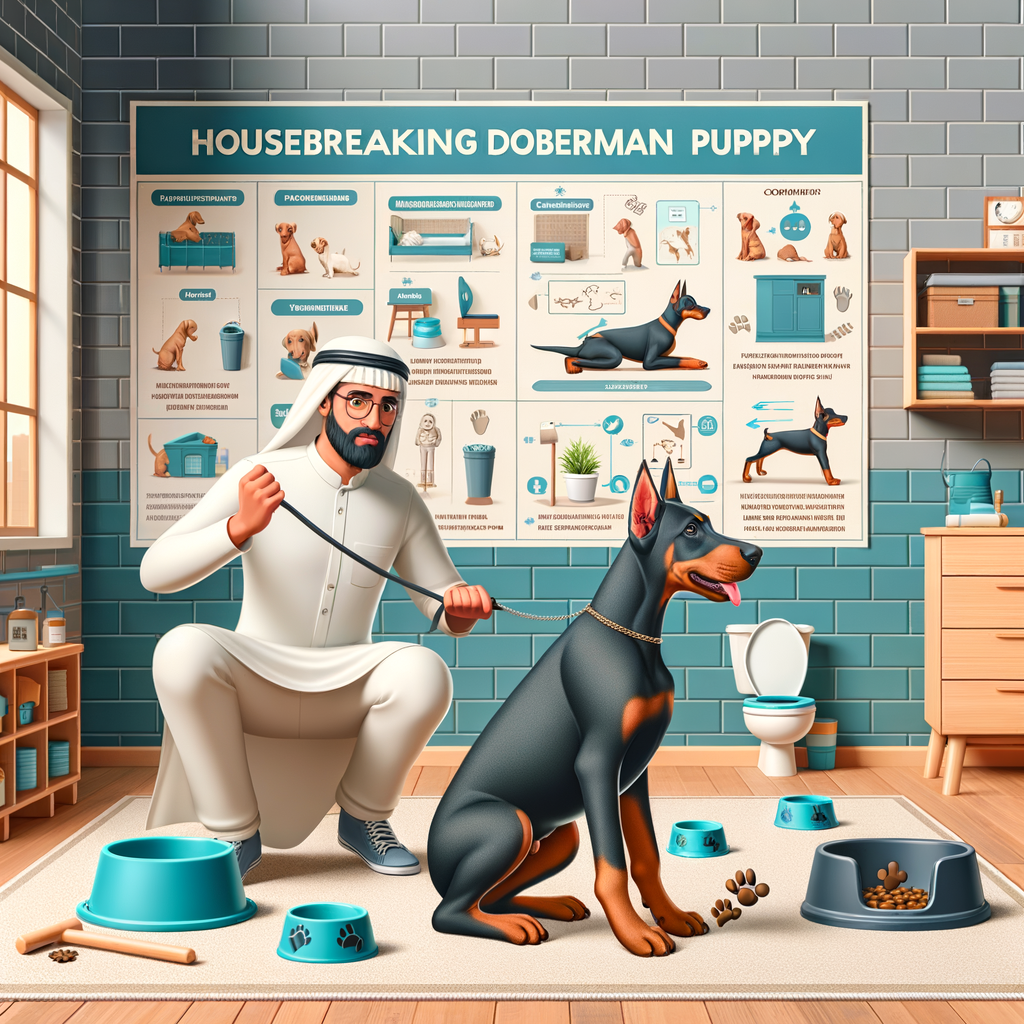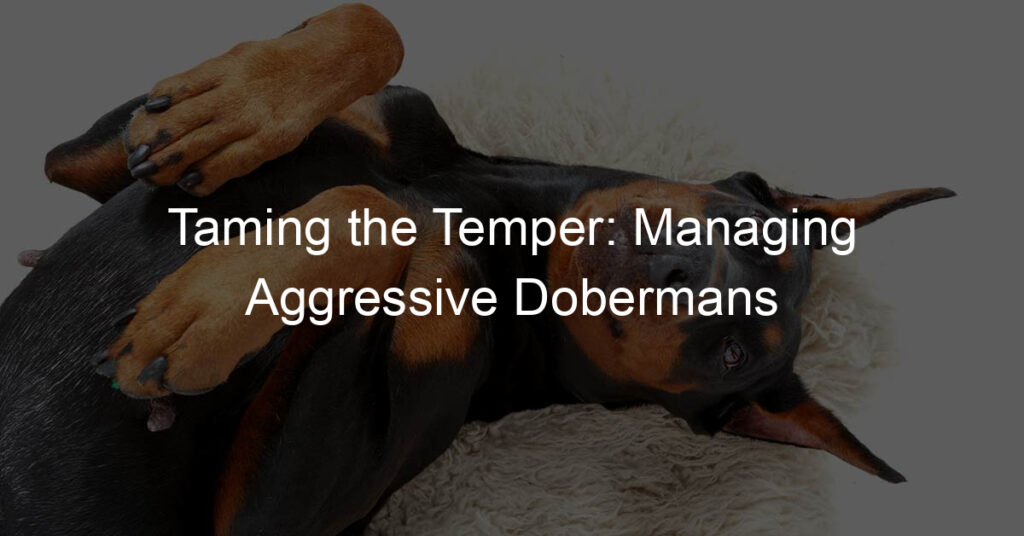
Introduction to Doberman Puppies Potty Training
Welcome to the world of Doberman puppies and their potty training needs. This guide will help you understand the importance of potty training and how to cater to your Doberman puppy’s specific needs. Let’s get started!
-
Understanding the Importance of Potty Training
Potty training is a crucial part of your Doberman puppy’s upbringing. It’s not just about keeping your home clean and odor-free. It’s about teaching your puppy discipline, setting boundaries, and establishing a healthy routine. Potty training can also help prevent health issues related to holding in waste for too long.
According to a study, puppies that are properly potty trained from a young age are less likely to develop behavioral issues later in life. So, it’s clear that potty training is not just a convenience for you, but a necessity for your puppy’s wellbeing.
-
Knowing Your Doberman Puppy’s Needs
Every breed has its unique needs, and Dobermans are no exception. Doberman puppies are intelligent and energetic. They require frequent bathroom breaks, especially during their early months.
Typically, a Doberman puppy needs to go potty after eating, drinking, playing, or waking up from a nap. It’s essential to understand these patterns to set up a successful potty training routine.
Remember, patience and consistency are key. It might take some time for your Doberman puppy to get used to the routine, but with your persistent efforts, they will eventually get there.
In the following sections, we will delve deeper into comprehensive potty training techniques, housebreaking tips, and mastering the art of potty training your Doberman puppy. Stay tuned!
Comprehensive Potty Training for Dobermans
Training your Doberman puppy to use the potty properly is an essential part of responsible pet ownership. It can be a challenging task, but with the right preparation and approach, it can be accomplished with ease. Let’s dive into the preparation phase of potty training your Doberman.
Preparation for Potty Training
Before you start the potty training process, there are two crucial steps you need to take: setting up a potty area and choosing the right time to start.
- Setting up a Potty Area
- Choosing the Right Time to Start
First, you need to designate a specific area in your yard or home where your Doberman puppy will go to the bathroom. This area should be easily accessible and kept clean at all times. It’s essential to consistently guide your puppy to this area whenever it’s time to go potty, as this will help them understand where they should relieve themselves.
Choosing the right time to start potty training is equally important. Most experts recommend starting when the puppy is between 12 and 16 weeks old. At this age, they have enough control over their bladder and bowel movements to learn to hold it. Remember, consistency is key in potty training. Make sure you have enough time and patience to devote to this process before you start.
In conclusion, preparing for potty training your Doberman involves setting up a designated potty area and choosing the right time to start the training. By taking these steps, you can set the stage for a successful potty training experience for both you and your Doberman puppy.
Doberman Puppy Toilet Training Techniques
Training a Doberman puppy to use the toilet can be a challenging task. However, with the right techniques, you can make the process much smoother and more effective. Here are three key techniques that can help you in this endeavor:
- Establishing a Routine
- Using Positive Reinforcement
- Dealing with Accidents
Just like humans, dogs thrive on routine. Establishing a consistent schedule for meals, playtime, and toilet breaks can help your Doberman puppy understand when it’s time to go to the bathroom. Start by taking your puppy out first thing in the morning, after meals, and before bedtime. Over time, your puppy will start to associate these times with going to the bathroom, making the training process easier.
Positive reinforcement is a powerful tool in puppy training. Whenever your Doberman puppy successfully uses the toilet, reward them with a treat, praise, or a favorite toy. This will help them associate the act of using the toilet with positive experiences, encouraging them to repeat the behavior. Remember, patience is key. It may take time for your puppy to fully grasp the concept, but with consistent positive reinforcement, they will eventually get there.
Accidents are bound to happen during the toilet training process. When they do, it’s important to handle them calmly and without punishment. Instead, clean up the mess promptly and continue with the training. If accidents are frequent, it may be a sign that your puppy is not understanding the routine. In this case, you may need to adjust your approach or consult with a professional dog trainer.
In conclusion, toilet training a Doberman puppy requires patience, consistency, and a positive approach. By establishing a routine, using positive reinforcement, and dealing with accidents calmly, you can help your puppy become fully toilet trained in no time.
Housebreaking Doberman Puppies
Training a Doberman puppy to be housebroken can be a challenging task, but with patience and consistency, it can be achieved. Housebreaking is an essential part of your puppy’s training and is crucial for maintaining a clean and healthy home environment. Let’s explore some tips that can make this process easier.
Doberman Puppies House Training Tips
Here are some effective tips to help you housebreak your Doberman puppy:
- Keeping a consistent schedule: Puppies thrive on routine. Establish a consistent schedule for feeding, playtime, and potty breaks. This helps your puppy understand when it’s time to eat, play, and go to the bathroom. For instance, you could take your puppy out first thing in the morning, after meals, and before bed.
- Monitoring your puppy’s diet: What your puppy eats can affect their bathroom habits. Feed your puppy a balanced diet and avoid giving them too many treats or human food, which can lead to irregular bowel movements. Remember to provide fresh water at all times, but consider limiting water intake before bedtime to reduce nighttime accidents.
- Understanding your puppy’s signals: Puppies often show signs when they need to go to the bathroom. They might start sniffing around, circling, or whining. Pay attention to these signals and take your puppy outside immediately. With time, your puppy will learn to associate these signals with going outside to do their business.
Remember, housebreaking a Doberman puppy requires patience and consistency. It’s a learning process for both you and your puppy. Celebrate small victories and don’t get discouraged if there are occasional accidents. With time and persistence, your Doberman puppy will become a well-trained member of your family.
Potty Training Tips for Doberman Puppies
Training a Doberman puppy to use the potty can be a challenging task. However, with patience, consistency, and the right approach, you can successfully housebreak your puppy. In this section, we will provide you with some valuable tips to make this process easier and more effective.
Training Doberman Puppies for Potty
When it comes to potty training your Doberman puppy, there are a few key strategies that can make the process smoother. Let’s delve into these strategies:
- Training in Different Environments
- Dealing with Separation Anxiety
It’s important to train your Doberman puppy in various environments. This helps them understand that the rule of going to the bathroom outside applies everywhere, not just at home. Start by training them in familiar places and gradually introduce them to new environments. Remember, patience is key during this process.
Doberman puppies are known to develop separation anxiety which can lead to accidents. To avoid this, create a comfortable space for your puppy where they feel safe. Use positive reinforcement when they spend time alone and gradually increase the duration. This will help them become more comfortable being alone and reduce the likelihood of accidents.
In conclusion, potty training a Doberman puppy requires patience, consistency, and a good understanding of your puppy’s needs. By following these tips, you can create a positive potty training experience for both you and your puppy.
Doberman Puppy Potty Training Techniques
Training your Doberman puppy to use the potty can be a challenging task, but with the right techniques, it can be made easier. The key is consistency, patience, and using proven methods that work well with this breed’s intelligence and eagerness to please.
Potty Training Methods for Doberman Puppies
There are several effective potty training methods for Doberman puppies. Here, we will discuss two of the most popular techniques: crate training and bell training.
- Using Crate Training
- Implementing Bell Training
Crate training is a highly effective method for potty training Doberman puppies. This method works on the principle that dogs do not like to soil their sleeping areas. Start by choosing a crate that is just big enough for your puppy to stand, turn around, and lie down in. Too much space and your puppy might use one corner as a bathroom.
Establish a routine where your puppy spends short periods in the crate and is taken out for potty breaks at regular intervals. Praise and reward your puppy when they do their business outside. Over time, your puppy will learn to hold it until they’re taken outside.
Bell training is another effective technique for potty training Doberman puppies. This method involves teaching your puppy to ring a bell when they need to go outside to use the bathroom. Start by hanging a bell near the door that you use to take your puppy outside for potty breaks. Each time you take your puppy out, gently nudge their nose or paw to ring the bell.
When your puppy rings the bell, praise them and immediately take them outside. With consistency and patience, your puppy will learn to associate ringing the bell with going outside to use the bathroom.
Remember, every puppy is unique and what works for one may not work for another. It’s important to be patient, consistent, and to try different methods until you find what works best for your Doberman puppy. With time and patience, your puppy will be potty trained and you can enjoy a clean, accident-free home.
Conclusion: Mastering Potty Training for Your Doberman Puppy
As we wrap up this comprehensive guide on potty training your Doberman puppy, let’s take a moment to revisit the key points we’ve covered.
- Recap of key takeaways:
- Understanding your Doberman puppy’s needs and habits is the first step in successful potty training.
- Establishing a consistent routine and using positive reinforcement techniques can significantly speed up the potty training process.
- Accidents will happen. It’s important to handle these situations calmly and patiently, using them as teaching moments.
- Various potty training techniques, such as crate training and bell training, can be effective for Doberman puppies.
- Importance of patience and consistency:
- Potty training isn’t an overnight process. It requires patience and consistency from you as the puppy’s owner. Remember, your puppy is learning a new skill, and that takes time.
- Consistency is key in potty training. Stick to your established routine and continue to use the same commands and signals to help your puppy understand what’s expected of them.
- Patience is crucial. There will be setbacks, but it’s important to remain patient and understanding. Your puppy is doing their best to learn, and your patience and encouragement will help them succeed.
In conclusion, mastering potty training for your Doberman puppy is a journey that requires time, patience, and consistency. But with the right approach and techniques, you can help your puppy become a well-trained member of your family. Remember, every puppy is unique and what works for one might not work for another. So, be open to trying different techniques and find what works best for your Doberman. Happy training!








